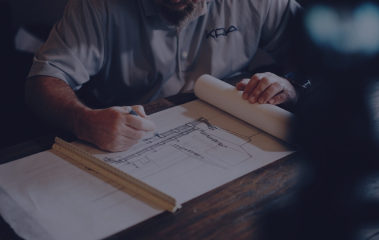Construction job costing is a fundamentally important process used in the construction industry. Construction project managers, estimators, accountants, contractors, owners, clients, regulatory authorities, and insurance companies all rely on accurate job costing for their records and for the purpose of making informed decisions.
Because a construction project has so many variables, it is critical to track progress and material costs meticulously to avoid cost overruns, disputes, and issues with non-compliance. Accounting software and innovations like time-tracking technology can help improve job costing accuracy.
What Is Construction Job Costing?
Construction job costing is the process of tracking and allocating material costs and other expenses to specific construction jobs. A manual or computerized job cost system can be used for this purpose.
Many types of costs are considered in this process, including overhead costs, labor costs, material costs, and soft costs like permits and professional fees. While some construction businesses track their costs independently, many engage construction CPA services to help them prepare accurate job cost reports.
Job Costing vs. Process Costing
Job costing and process costing are two different costing methods that are used in accounting to find the costs of producing certain goods or services. Both link expenses to product completion, but are applied in different kinds of production arenas.
Job Costing
This method is used for industries that produce personalized goods or services, such as construction projects, custom manufacturing, and professional services. The job costing system treats each job as its own cost entity and project costs are assigned to the individual aspects of the project or steps to completion.
Process Costing
Process costing is used in industries that either mass-produce products or use repetitive procedures. Costs are averaged from all the units produced during a certain time frame, then each unit is given the same calculated average cost.
Benefits of Job Costing for Construction Businesses
Tracking costs on specific projects brings numerous benefits for developers and construction companies, including:
- Accurate Estimates and Budgeting: Account managers can compare the budgeted amounts to the real-time expenses that are connected to a particular job to improve the accuracy of future estimates.
- Cost Control: Actual costs often exceed the original estimated costs. Managers can find these discrepancies and make adjustments to control the costs as the project progresses.
- Client Billing: Clients want to see accurate job cost reports. Keeping detailed construction job costing records ensures clients are billed accurately and builds trust.
- Protection in the Case of a Dispute: Construction projects involve legal contracts between the company or general contractor, the client, and any subcontractors involved. Keeping accurate records of job expenses and making sure you stay within the agreed-upon budget can prevent legal disputes down the track and increase the likelihood of securing more jobs with this client and their contacts in the future.
- Company Transparency: Accurate job costing is essential if your company has shareholders and you are required to present financial reports to your board of directors. A CPA can explain the implications of your construction company’s business structure on the kinds of financial records you are required to keep.
How to Track Construction Job Costs
One should pay meticulous attention to the details of the cash flow of each specific project. This is where knowing how job costing for construction works is imperative! Your business may want to consider hiring outsourced accounting services to improve accuracy in job costing and ultimately strengthen the financial health of your business.
Calculating the total job cost requires the allocation of all costs associated with completing a unique construction project using the correct job costing formula. This includes labor costs, subcontractor costs, materials, equipment, overhead, and soft costs.
Labor Costs
To calculate your labor costs, first record the number of hours each laborer has given to the project. Next, multiply the number of hours worked by the pay rate plus benefits, workers’ compensation, and overtime. This will give you the total cost for each worker. Finally, add all of the workers’ total costs together to find the total labor cost of the construction job.
Construction projects typically involve both direct and indirect labor costs. Direct labor costs involve workers who are working directly on the job whereas indirect labor costs involve employees such as supervisors or other support staff from the construction business. The American construction industry employs 8 million workers, so keeping track of labor is a very important task for construction companies and developers.
Subcontractor Costs
Keep track of all committed costs and services provided by any subcontractor working for the construction company. Subcontractor job costing can be broken down by certain developments or completed tasks.
Make sure to include any additional expenses like rentals or travel and check that the subcontractor’s costs are not greater than the contract amount you previously agreed upon.
Cost of Materials
Maintain records of all purchased materials including quantities and costs per unit. Materials used by construction companies should also be categorized by type. For instance, concrete, steel, and electrical aspects should all be documented separately. Any waste, spoilage, or delivery charges should also be taken into account.
To calculate the cost of materials for a job, multiply the unit cost by the number of units purchased. Then, combine the totals for each type of material to find the total cost of materials for that project.
Equipment Costs
Depreciation and maintenance costs should be included for any owned equipment that is used in a construction project. For equipment that is only used temporarily, take note of the actual costs of rental fees or leases. Hourly or job-specific equipment rates should be carefully tracked and documented.
To find the equipment cost for a specific job, multiply the hourly or job-specific rate of each piece of equipment by its actual usage from the start to the end of the job. Then, add all the individual equipment costs together to find the total equipment cost for the job. Please note that safety equipment is included in this category.
Overhead Costs
The overhead costs for a construction job include things like utilities, rent of a temporary office space, and administrative expenses. “Fixed” overhead costs are those that are always the same—such as rent or insurance—while “variable” overhead costs include usage-based charges like utilities.
There are several methods construction companies can use to allocate the appropriate amount of overhead to a job so that all of the company’s overhead is accounted for. This includes methods based on labor hours, square footage, or equipment usage. Alternatively, companies can use the activity-based costing (ABC) method to allocate their overhead costs to specific jobs.
Soft Costs
Soft costs include expenses like permits, surveys, bank fees, inspection fees, and legal fees—expenses that are necessary but don’t directly advance the construction process. Take note of all of the job-related expenses that could be included in this category and allocate them according to their connection with each job.
Tips for Making Your Job Costing More Accurate
A stellar job costing process for construction companies is important for positive cash flow and making sure profit margins are in an optimal range. Apply these tips to make your job costing process more accurate.
Use Construction Accounting Software
Utilize well-rounded construction accounting software to help analyze granular costs and examine any cash flow discrepancies. Using a software-based job cost system can also reduce manual errors and streamline the costing process.
Use Standardized Cost Codes
Develop a standardized cost code system to facilitate easier tracking, more accurate estimates, and cost comparisons. Make sure that everyone in the company is informed of your cost code system and applies these codes consistently.
Use Time-Tracking Technologies
Laborers may be on location in Fort Lauderdale, Florida working on a job while the central office is located in Irving, Texas. Mobile apps or other geolocation systems help accurately record employee hours worked. This improves the accuracy of employee work hours and reduces losses due to time theft.
Conduct a Post-Job Analysis
Conducting a post-job analysis to evaluate the accuracy of initial estimates helps you find areas for improvement in the business. Analyzing discrepancies in actual and estimated costs also helps to refine future cost estimations. Professional job costing software can be invaluable for this task.
Optimize Your Job Costing Process
It’s essential to stay up to date on emerging technologies, regulatory changes, and other new processes that can be incorporated to optimize your job costing process. You can improve your profit margins by implementing feedback loops to utilize wisdom gained from past projects.
Barry Ritholtz, co-founder of Ritholtz Wealth Management LLC, once wisely said, “Have a well-thought financial plan that is not dependent upon correctly guessing what will happen in the future.” Accurate construction job costing helps you achieve just that.















